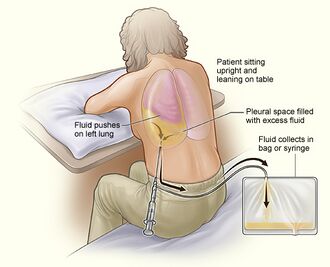Thoracentesis: Difference between revisions
Reem Ramadan (talk | contribs) No edit summary |
Reem Ramadan (talk | contribs) No edit summary |
||
| Line 1: | Line 1: | ||
<div class="editorbox"> '''Original Editor '''- [[User:Reem Ramadan|Reem Ramadan]] '''Top Contributors''' - {{Special:Contributors/{{FULLPAGENAME}}}}</div> | <div class="editorbox">'''Original Editor '''- [[User:Reem Ramadan|Reem Ramadan]] '''Top Contributors''' - {{Special:Contributors/{{FULLPAGENAME}}}}</div> | ||
<div class="noeditbox">This article or area is currently under construction and may only be partially complete. Please come back soon to see the finished work! ({{REVISIONDAY}}/{{REVISIONMONTH}}/{{REVISIONYEAR}})</div> | <div class="noeditbox">This article or area is currently under construction and may only be partially complete. Please come back soon to see the finished work! ({{REVISIONDAY}}/{{REVISIONMONTH}}/{{REVISIONYEAR}})</div> | ||
[[File:Thoracentesis.jpg|alt=The illustration shows a person having thoracentesis. The person sits upright and leans on a table. Excess fluid from the pleural space is drained into a bag.|right|frameless|330x330px]] | |||
== Description == | == Description == | ||
Thoracentesis is a minimally invasive procedure that involves removing excessive fluid or air from the lungs by injecting a hollow needle through the chest wall and into the pleural space after the administration of local anesthesia. This procedure can be done in either a sitting or supine position depending on the patient's comfort and his underlying condition<ref>LeVasseur RA. Thoracentesis. In: Richardson JD, Bland KI, editors. The Mont Reid Surgical Handbook. 6th ed. Philadelphia, PA: Saunders/Elsevier; 2008. p. 835-838. </ref>. | |||
== Indication == | == Indication == | ||
Revision as of 13:22, 1 June 2023
Description[edit | edit source]
Thoracentesis is a minimally invasive procedure that involves removing excessive fluid or air from the lungs by injecting a hollow needle through the chest wall and into the pleural space after the administration of local anesthesia. This procedure can be done in either a sitting or supine position depending on the patient's comfort and his underlying condition[1].
Indication[edit | edit source]
Clinical Presentation[edit | edit source]
Resources[edit | edit source]
References[edit | edit source]
- ↑ LeVasseur RA. Thoracentesis. In: Richardson JD, Bland KI, editors. The Mont Reid Surgical Handbook. 6th ed. Philadelphia, PA: Saunders/Elsevier; 2008. p. 835-838.







